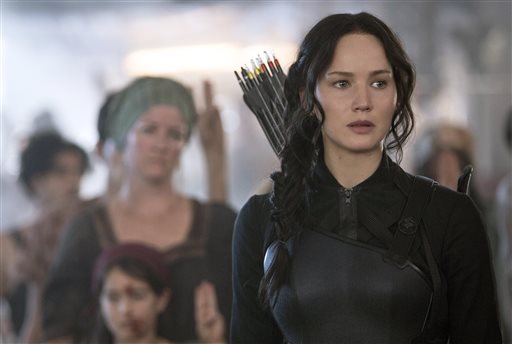
In this image released by Lionsgate, Jennifer Lawrence portrays Katniss Everdeen in a scene from “The Hunger Games: Mockingjay Part 1.” AP
LOS ANGELES — All is not well in Panem. At the conclusion of “The Hunger Games: Catching Fire,” Katniss’s (Jennifer Lawrence) force-field shattering arrow left the society in turmoil. The desperate act was perceived as subversion, inciting populist uprisings and devastating counter attacks by the governing elite.
Thus, revolution is on the horizon in the franchise’s third installment, “Mockingjay – Part 1,” and it all hinges on Katniss, the unwitting face and spirit of the movement. You see, Katniss, much like the movie star actress who plays her, is just generally liked. Everything she does is slapped with meaning and significance, regardless of her intentions. She has become the property of the people.
This has always been clear to Plutarch Heavensbee (Philip Seymour Hoffman), who aims to use her as a propaganda machine. But there’s a problem: the girl on fire has flamed out.
In the chaos that followed the conclusion of the second film, Peeta (Josh Hutcherson) was captured by the Capitol, District 12 was destroyed (though Katniss’ mother, sister and the steely jawed Gale (Liam Hemsworth) escaped alive), and Katniss was taken by the militaristic District 13. Their President, Alma Coin, (franchise newcomer Julianne Moore) needs her to be their poster girl.
“Mockingjay – Part 1” is, ultimately, a slow-burn portrait of the repeated rise and fall of dystopia’s most reluctant hero, nimbly told through its examination of the mechanics of propaganda. With the help of Plutarch, Haymitch (Woody Harrelson) and the toned-down (but still delightful) Effie Trinket (Elizabeth Banks), Katniss attempts to serve the cause in her own way.
But it’s not just a matter of convincing her to forget, or at least shelve, her past traumas. Katniss’s confidence and devotion to the revolt is put to the test when she sees how the evil President Snow (Donald Sutherland) is manipulating Peeta and using him for his own propaganda needs.
In this image released by Lionsgate, Liam Hemsworth portrays Gale Hawthorne in a scene from “The Hunger Games: Mockingjay Part 1.” AP
In the Games, the goal was simple: Keep Peeta alive. Now, Katniss is powerless, just a tool of the machine. Charred and fatally wounded bodies aside, “Mockingjay – Part 1” is not for the faint of heart when it comes to the relentless emotional torture of its heroine.
Director Francis Lawrence, in his second outing in the franchise, stays fairly true to the original text, carrying over the war-torn bleakness of “Catching Fire” without any of the disturbing thrill of the Games. He sprinkles in a handful of fairly exciting action sequences (one of which was not actually described in the book), but, he mostly allows the film to luxuriate in the quiet moments. Yet too many involve Katniss tearing up while sitting on piles of rubble.
In its best moments, the movie has a tense, night before the battle feel. Only the battle is still a year away.
Ever since the “Harry Potter” juggernaut split their final story into two separate films, it’s become standard practice in Hollywood for every successful franchise, regardless of whether or not the story is there. “Mockingjay – Part 1” is a serviceable entry into the conclusion of Katniss’s saga. It boasts some imaginative visuals, a few truly thrilling moments, and standout performances from Lawrence, Banks, Harrelson, and Hoffman, to whom the film is dedicated.
Still, even with Hoffman’s subtly brilliant reaction shots, it does not seem to be the type of movie that fans will revisit on its own. This half is part of a whole in the most cynical way.
You say you want a revolution? They’ll get to that next year.
“The Hunger Games: Mockingjay – Part 1,” a Lionsgate release, is rated PG-13 by the Motion Picture Association of America for “intense sequences of violence and action, some disturbing images and thematic material.” Running time: 123 minutes. Two and a half stars out of four.
RELATED STORY
From book to film: ‘Hunger Games’ delves further into dystopian world